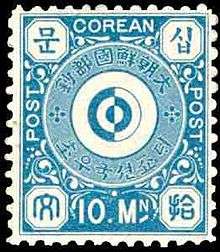Postage stamps and postal history of Korea

.jpg)

This is a survey of the postage stamps and postal history of Korea. Before a strict isolationist country, Korea began to open up in the second half of the 19th century.
Stamps of Joseon dynasty
Joseon issued its own first stamps on 18 November 1884 when the first postal service was created. While five values were printed - 5, 10, 25, 50, and 100 mon, only the 5m and 10m values were issued, and even these saw little use, as the post office was burned down during a revolt in December 1884.
The next series of stamps did not appear until 1895, and consisted of four values: 5, 10, 25, and 50 poon, all of the same design featuring a taegeuk symbol. They were overprinted "Dae Han" in 1897, and surcharged to 1 poon in 1900.
Stamps of Korean Empire
A currency change in 1900, to rin, cheun, and weun, necessitated new stamps, and accordingly a series of 13 was issued, with values ranging from 2 rin to 2 weun. While all the designs have a common theme of the taegeuk symbol, the frames are different for each value, and the three highest values are printed in two colors each. In 1902 five of these were surcharged using black handstamps.
Korea issued its first commemorative stamp on 18 October 1902, marking the 40th anniversary of the reign of Emperor Gojong. The orange stamp depicted the emperor's crown. The last stamps of the Empire were another series of 13 issued in 1910, with all stamps of a common depicting a falcon symbol.
However, in 1910, Japan assumed administrative control of Korean Empire, and subsequently all mail used Japanese Chosēn stamps. This state of affairs continued until early 1945 after liberation.
See also
- Postage stamps and postal history of North Korea
- Postage stamps and postal history of South Korea
- Japanese post in Korea
Sources
| Wikimedia Commons has media related to Stamps of Korea. |
- Stuart Rossiter & John Fowler (1991). World History Stamp Atlas (reprint ed.). pub: Black Cat. ISBN 0-7481-0309-0.
- Scott catalogue